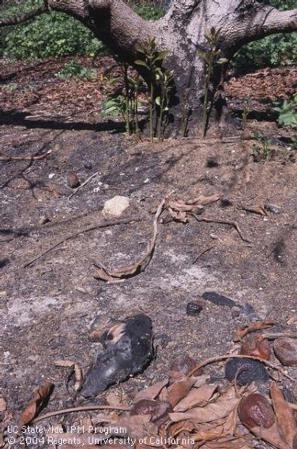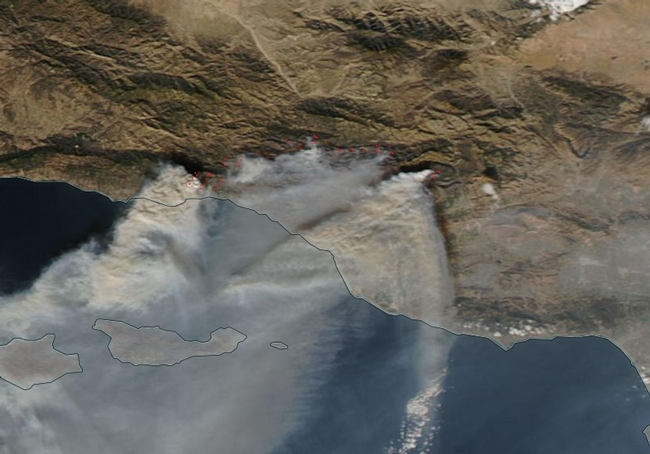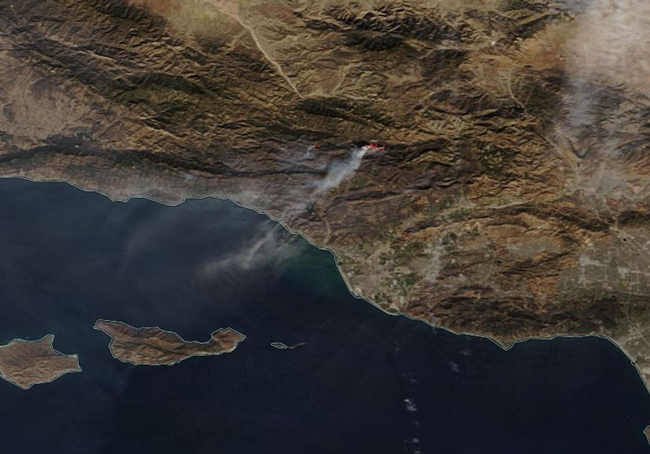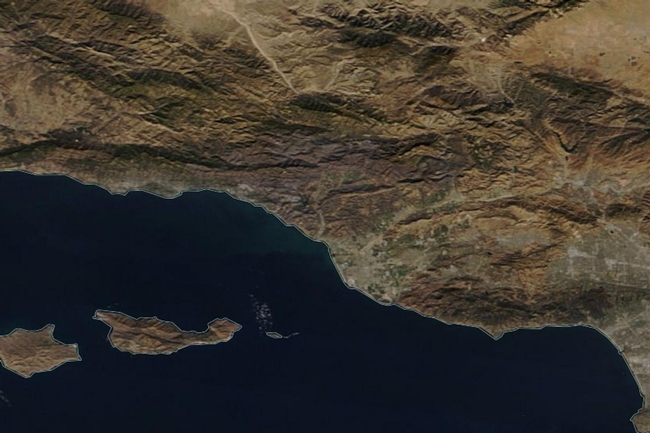- Author: Ben Faber
As firefighters in Southern California worked to achieve full containment on the Thomas Fire, agricultural officials in Ventura County issued their first estimate of damage to crops and farm structures, reporting that losses will exceed $171 million, with more than 70,000 acres of cropland and rangeland affected.
The Ventura County agricultural commissioner's office based its initial assessment on information about agricultural locations within the perimeter of the fire, which started on Dec. 4 and grew into the state's largest wildfire, burning nearly 282,000 acres as of late last week.
In a preliminary disaster report to the U.S. Department of Agriculture, Ventura County Agricultural Commissioner Henry Gonzales estimated more than 10,289 acres of irrigated cropland and another 60,000 acres of rangeland in the county had been affected by the fire. He estimated the cost of the damage to current and future crops, machinery and equipment, dwellings, service buildings and other structures at nearly $171.3 million, with avocados and citrus crops suffering the highest losses.
The estimates do not include wage losses of farm employees, the report said, and “nothing can measure the pain and suffering of the farmers that have lost much of their livelihood.”
A more-exact assessment won't be completed until late spring to early summer, Gonzales said, as his office continues to conduct on-the-ground surveys and receive surveys back from growers. What's uncertain at this point, he said, is how well the tree crops will recover.
“The rather complicated part about damage on avocado and lemon trees is that the damage isn't readily apparent,” he said. “You can't really tell the damage until sometime in the future.”
Farmers will have a better idea in the spring, when their trees either bloom or won't bloom, Gonzales said. Even then, they won't know the extent of the trees' recovery until summer, when they can evaluate the crop itself. Aerial photography, he noted, will allow officials to see crop damage as it manifests.
In Santa Barbara County, which was also affected by the Thomas Fire, Assistant Agricultural Commissioner Rudy Martel said it will be a few more weeks before his office can provide an initial damage assessment. He noted it had been less than two weeks since mandatory evacuations in the region had been lifted, and growers had just begun to return to their properties.
“The growers have not been in contact with us,” he said. “We rely on their information, and it takes them a while to get those numbers to us because they're trying to get back into production, to start their business back up.”
He said he hopes a grower assistance workshop in Carpinteria later this week will provide the office its “first opportunity to touch base” with growers and gather initial damage estimates.
In Ventura County, the fire has so far cost avocado growers an estimated $10.2 million in losses, Gonzales reported. The county has about 18,500 acres of avocados, with 6,603 acres affected by the fire and 1,250 acres that suffered damage. Some 4,030 tons of fruit have been lost.
For citrus fruit, the county's lemon crop saw more than $5.8 million in losses, with 7,591 tons of lost fruit. Of the county's 14,800 acres of lemons, 1,767 acres were affected by the fire and 400 acres were damaged. Oranges suffered losses of about $3.4 million, while the cost to mandarins reached $491,022 and grapefruit losses totaled $35,930.
Other affected commodities include vegetables, with damage and losses totaling $4.6 million; miscellaneous fruit, $1.4 million; nursery crops, $1.4 million; strawberries, $486,416; rangeland, $480,000; apiaries, $139,500; hay and grain, $129,345; cattle, $125,000; cut flowers, $61,966; and raspberries, $55,420.

The preliminary estimate of nearly $171.3 million in agricultural losses in Ventura County from the Thomas Fire includes $25 million in lost farm machinery and equipment.
Photo/John Krist
Ventura County farmers and ranchers also face costs to replace and repair destroyed or damaged buildings, equipment and other structures. Gonzales estimated the fire destroyed 260 agricultural dwellings, service buildings and other structures. Another 215 buildings and structures suffered major or minor damage. Together, they were valued at a loss of $113 million.
The report estimated the cost to replace farm machinery and equipment at $25 million. Cost of land damages, including cost to replace trees, reached $3.4 million, while loss of irrigation systems totaled another $1.1 million.
“There were many homes, many structures that were lost,” Gonzales said. “Our very water-efficient irrigation systems, because they're made out of plastic, melted, so all of those will have to be replaced.”
Restoring irrigation systems is critical, he said, because of the region's ongoing drought conditions and lack of precipiation this season. Using water trucks is not an option, he added, because of the large number of affected acres that need watering. Because of high demand, he said there's been a local shortage of irrigation components, and some growers have had to order them or go out of the area to buy parts.
Mallory Salant, district manager of Fruit Growers Supply in Santa Paula, said the fire led to skyrocketing demand for certain items.
“Aboveground irrigation parts are flying off the shelves,” she said. “A couple of days after the fire started, we were completely out of stock and it was very chaotic in the showroom.”
Irrigation tubing is currently the most sought-after item. At other times, a typical order might be 10 or 20 rolls of tubing, she said, but now farmers are ordering 200 to 400 rolls because they need to replace all of the tubing on their farm.
Despite the high demand, Salant said the store has managed to “stay on top of it” by working with vendors to restock quickly.
“At this point, our shelves are full,” she said.
by Ching Lee, assistant editor of Ag Alert/credit California Farm Bureau Federation
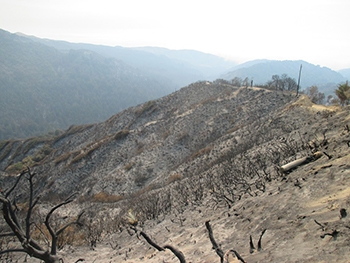
- Author: Ben Faber
University of California Cooperative Extension, USDA Farm Service Agency, California Avocado Commission and California Avocado Society
Fire Recovery and Frost Refresher
Santa Paula Agricultural Museum, 926 Railroad Ave, Santa Paula
January 10, 9 – 11 AM, Wednesday
Introduction – Ben Faber, UCCE
Fire Damage to Santa Barbara and Ventura County Agriculture – Henry Gonzales, VC Ag Commissioner
Damage to Avocado Orchards – Ken Melban, CAC
Disaster Resources Available from USDA – Farm Service Agency – Daisy Banda, USDA- FSA
Assessing Fire and Frost Damage and Recovery Practices – Ben Faber
Fire Loss Calculator – Eta Takele, UCCE
Fire Experiences – What Works, What Doesn't and What Might – Grower Panel
Representatives from Ventura and Santa Barbara Agriculture Commissions will be present
FSA will be present from 8-12 to take Disaster Applications
Refreshments will be served.
For information contact: Ben Faber (805)645-1462
The University of California prohibits discrimination against or harassment of any person employed by or seeking employment with the University on the basis of race, color, national origin, religion, sex, physical or mental disability, medical condition (cancer-related or genetic characteristics), ancestry, marital status, age, sexual orientation, citizenship, or status as a covered veteran (special disabled veteran, Vietnam-era veteran or any other veteran who served on active duty during a war or in a campaign or expedition for which a campaign badge has been authorized).
University Policy is intended to be consistent with the provisions of applicable State and Federal laws.
Inquiries regarding the University's nondiscrimination policies may be directed to the Affirmative Action/Staff Personnel Services Director, University of California, Agriculture and Natural Resources, 300 Lakeside Dr., 6th Floor, Oakland, CA 94612-3550 (510) 987-0096.
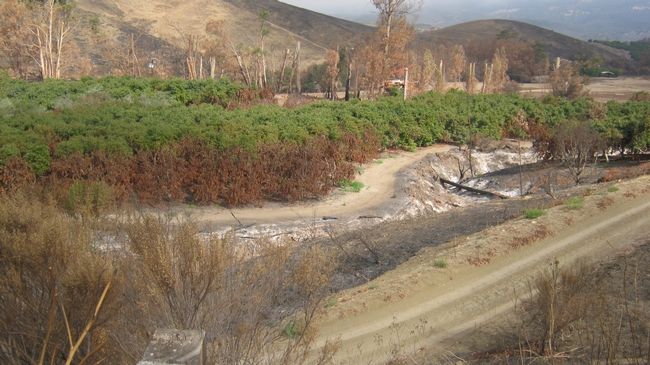
- Author: Ben Faber
USDA's Farm Service Agency (FSA) offers disaster assistance and low-interest loan programs to assist agricultural producers in their recovery efforts following wildfires or other qualifying natural disasters. Available programs and loans include:
- Non-Insured Crop Disaster Assistance Program (NAP)
- - provides financial assistance to producers of non-insurable crops when low yields, loss of inventory, or prevented planting occur due to natural disasters including excessive wind and qualifying drought (includes native grass for grazing). Eligible producers must have purchased NAP coverage for 2017 crops. A notice of loss must be filed within 15 calendar days of when the loss is apparent or 15 calendar days after the normal harvest date.
- Livestock Indemnity Program (LIP)
- - offers payments to eligible producers for livestock death losses in excess of normal mortality due to adverse weather. Eligible losses may include those determined by FSA to have been caused by hurricanes, floods, blizzards, wildfires, tropical storms, tornados lightning, extreme heat, and extreme cold. Producers will be required to provide verifiable documentation of death losses resulting from an eligible adverse weather event and must submit a notice of loss to their local FSA office within 30 calendar days of when the loss of livestock is apparent.
- Tree Assistance Program (TAP)
- – provides assistance to eligible orchardists and nursery tree growers for qualifying tree, shrub and vine losses due to natural disasters including excessive wind and qualifying drought.
- Emergency Assistance for Livestock, Honeybees, and Farm-Raised Fish Program (ELAP)
- - provides emergency relief for losses due to feed or water shortages, disease, adverse weather, or other conditions, which are not adequately addressed by other disaster programs. ELAP covers physically damaged or destroyed livestock feed that was purchased or mechanically harvested forage or feedstuffs intended for use as feed for the producer's eligible livestock. In order to be considered eligible, harvested forage must be baled; forage that is only cut, raked or windrowed is not eligible. ELAP also covers up to 150 lost grazing days in instances when a producer has been forced to remove livestock from a grazing pasture due to wildfire and for beekeepers, ELAP covers beehive losses (the physical structure) in instances where the hive has been destroyed by a natural disaster including flooding, high winds and tornadoes. Producers must submit a notice of loss to their local FSA office within 30 calendar days of when the loss is apparent.
- Emergency Loan Program
- – available to producers with agriculture operations located in a county under a primary or contiguous Presidential or Secretarial disaster designation. These low interest loans help producers recover from production and physical losses.
- Emergency Conservation Program (ECP)
- - provides emergency funding for farmers and ranchers to rehabilitate land severely damaged by natural disasters; includes fence loss.
- HayNet
- - is an Internet-based Hay and Grazing Net Ad Service allowing farmers and ranchers to share ‘Need Hay' ads and ‘Have Hay' ads online. Farmers also can use another feature to post advertisements for grazing land, specifically ads announcing the availability of grazing land or ads requesting a need for land to graze. www.fsa.usda.gov/haynet.
www.fsa.usda.gov/disaster
For more information on these programs, visit FSA online at www.fsa.usda.gov.
To find a local FSA office near you, visit
http://offices.usda.gov.
USDA is an equal opportunity lender, provider and employer.
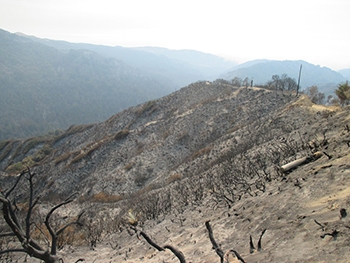
- Author: Ben Faber
What a difference a few days can make in the life cycle of a fire. In this particular case, the Thomas Fire that is ongoing in the Ventura County around (and surrounding) in Southern California. The following images were taken by the Terra and Aqua satellites on Dec. 16, 17, and 19, 2017, and during those times fire conditions improved visibly. A difference in winds, in humidity, in the ability of firefighters to control the fire's perimeter, and in the amount of fuel left for the fire to consume can bring a raging fire to heel. This does not mean the fire cannot gain strength again if conditions worsen, but it is heartening to realize that weather conditions can allow firefighters to get a better handle on events as they have in the last few days.
This the the Thomas Fire on December 16, 2017 as seen by the Terra satellite. There were multiple areas of "hot spots" where the satellite indicates the fire is and where telltale smoke also pinpoints fire spots. These areas are numerous and the clouds of smoke coming off the flames are all consuming.
By December 17, 2017, conditions had obviously changed for the better and the fires were able to be somewhat contained. This image taken by the Aqua satellite on December 17, 2017, shows a much more subdued Thomas Fire. There are still hot spots visible but the number has vastly improved.
By December 19, 2017, hot spots are not showing up via satellite instruments. This does not mean the fire is completely out, but large hot spots are no longer detected by satellites. So, too, the copious smoke that was spewing from the fires is no longer in evidence. This Aqua image shows a much calmer landscape due to improving weather conditions at the time.
Per Inciweb today, the Thomas fire is 60 percent contained at present. At 272,000 acres, the Thomas Fire is now the second largest fire in the recorded history of the state of California. Unfortunately, weather conditions that allowed the fire to be contained to the 60 percent mark are destined to change as weather conditions deteriorate this afternoon. Inciweb reports that a forecasted strong north wind event will bring wind conditions similar to those experienced when the fire made its push into Montecito. With the introduction of these winds, critically dry fuels will be highly receptive to fire spread. During Santa Ana wind events three things happen: the weather warms, winds pick up, and humidity drops precipitously. All of these events promote fire growth. The Thomas Fire has experienced winds exceeding 70 miles per hour, temperatures in the mid 80's and humidity below 10 percent.
###
NASA image courtesy NASA Worldview application operated by the NASA/Goddard Space Flight Center Earth Science Data and Information System (ESDIS) project. Caption by Lynn Jenner with information from Inciweb.
- Author: Gary Bender
This is from past experience, and is still relevant. Availability of replant trees is a major issue to consider at this point.
The wildfires in San Diego and Ventura Counties during the fall of 2003 were certainly devastating to many avocado groves adjacent to burning native chaparral. Many of the avocado trees were singed in the canopy without extensive damage to the large scaffold branches; these trees will re-grow new foliage with some relatively minor pruning to clear out smaller dead branches. However, other groves have had extensive damage, complete with charring of the bark in the trunk and boiling of the sap through the bark of the trunk. In these cases, the sap became hot enough to steam the cambium layer (the layer of living cells just beneath the bark), killing the tree above the soil line.
In the latter case, the tree above the soil line is dead, but the roots are still alive. Beginning about the first of March 2004, we have noticed that many of these trees are sending up rootstock suckers near the trunk. If left to grow un-grafted, these suckers will become an avocado tree, but not a known cultivar. The question is: should these burned trees be removed and replanted with a new tree? Or should a sucker be tip-grafted back to a known cultivar?
Sucker grafting in avocado is a well-known practice and has been used extensively in the industry when a grower desired to change cultivars. Generally, the tree is cut down leaving a threefoot stump, which is used as a stake for the new tree. A strong sucker growing from the base of the tree is selected (the sucker should be about 3/4 to 1" in diameter and stiff, not rubbery), and the other smaller suckers should be removed. The sucker is cut with a horizontal cut about 6-8" above the soil line, a 2”vertical slit is made down through the center of the sucker, and 3" to 4" long piece of budwood, cut like an arrowhead at the bottom end, is slipped into the slit, matching the cambium layers together on at least one side, and preferably on both sides. The graft is wrapped tightly with grafting tape, and the entire budstick is wrapped with Parafilm to prevent moisture loss, and grafting tape is used to tie the new grafted sucker to the stump (used as a stake).
Advantages from sucker grafting (as opposed to planting a new tree).
- Sucker grafting is cheaper. As recently quoted by a grafter in Fallbrook, sucker grafting usually costs about $2 per tree after the tree has been cut down to a 3 foot stump. If the grafter supplies the budwood and grafting tape, the price will probably be $2.50 per tree. If the grafter has to travel away from Fallbrook, the price will be higher according to the distance traveled. A new replacement tree will cost about $14 on a seedling rootstock, or $19-22 on a clonal rootstock. The labor cost for planting the new tree would be about $2.00 per tree. These costs do not include cutting down the older burned tree, or follow-up care for the young tree.
- The older, burned avocado tree has an extensive root system with a lot of stored energy. When the sucker graft begins to grow it usually grows very rapidly, much faster than a young replant tree. The sucker grafted tree should start to set fruit two years after grafting.
Disadvantages from sucker grafting.
- We are assuming that the sucker-grafted tree is healthy and does not have root rot or some other disease. If the older tree has root rot, it would be better to remove the old tree and replant with a new tree grown on one of the newer root-rot tolerant clonal rootstocks.
- In the system described above, the trunk is used as a stake. When the new tree grows enough to be selfsupporting, the old stump should be cut down close to the ground. The stump should be slightly sloped to drain water away from the new tree. This takes some careful chainsaw work.
- Suckers. Until the new tree gains strength and starts to shade the old stump, there will be other suckers emerging. These must be removed or they will take over and shade the grafted sucker.
